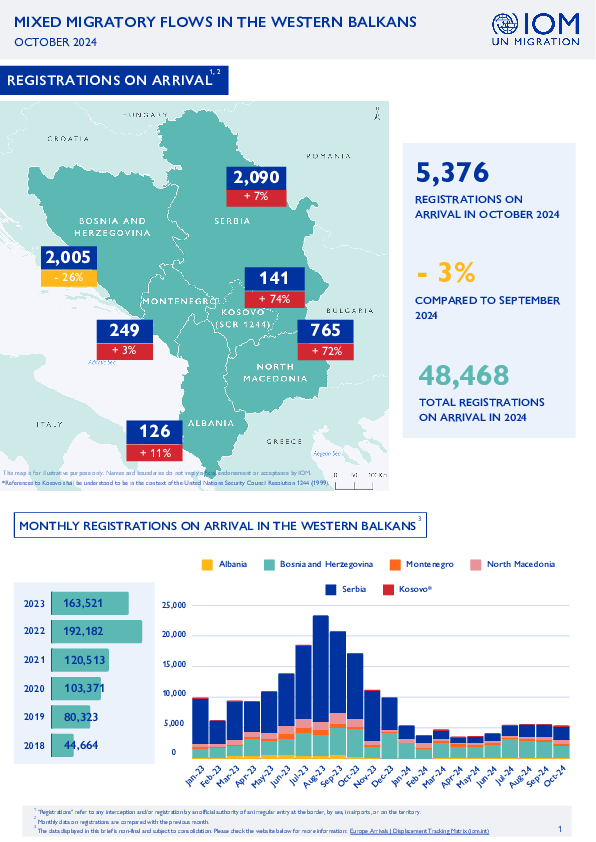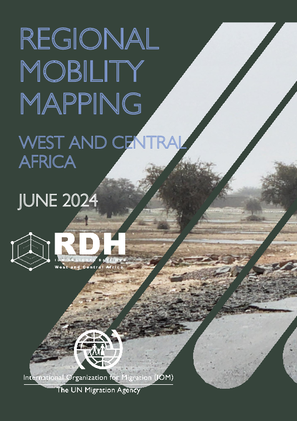-
Countries
-
Data and Analysis
-
Special Focus
-
Crisis Responses
No
Monthly overview of:
- Arrivals in the Western Balkans
- Top three nationalities at arrivals in the reporting month
- Migrants presence in reception facilities
- Assisted Voluntary Returns and reintegration
Monthly overview of:
- Arrivals in the Western Balkans
- Top three nationalities at arrivals in the reporting month
- Migrants presence in reception facilities
- Assisted Voluntary Returns and reintegration

Contact
DTMMozambique@iom.int
Language
English
Location
Mozambique
Period Covered
Oct 23 2024
Nov 12 2024
Activity
- Mobility Tracking
- Event Tracking
- 23 October and 12 of November 2024, attacks in Meluco, Mueda, Muidumbe, Mocimboa da Praia and Nangade displaced 6,221 individuals (1,481 families); urgent needs include food, shelter, and WASH as detailed in Movement Alert #117.
- Displacement trends between 23 October and 12 of November 2024, show a spike at 2,162 individuals on 8 November and 1,114 on the 7 November, indicating intensified movement due to increased attacks and fear of violence.
- Current movement patterns show Nangade (Litingina) to Nangade Sede and M’Tamba within Nangade district as the largest displacement flow with 3,120 individuals, followed by Chapa (Oumba) to Chapa (Nanhala) with 2,146 individuals alongside smaller movements from Meluco, Diaca, Mapate, and Mbau to nearby safer areas, highlighting the spread of displacement within local communities.
Monthly overview of:
- Arrivals in the Western Balkans
- Top three nationalities at arrivals in the reporting month
- Migrants presence in reception facilities
- Assisted Voluntary Returns and reintegration
Le développement et la mise en œuvre de programmes et politiques migratoires favorisant une migration sûre, ordonnée et légale en Afrique de l’Ouest et du Centre requière une meilleure compréhension des mobilités humaines dans la région.
La mobilité régionale prend différentes formes. La transhumance, la migration saisonnière lors des saisons des récoltes et des extractions de minerais, la migration économique à destination de l’Afrique du Nord et de l’Europe, les mouvements liés aux fêtes religieuses et culturelles, le tourisme, les mouvements étudiants, les déplacements forces, l’exode rural, et les migrations environnementales, sont des exemples de mouvements observes en Afrique de l’Ouest et du Centre, reflétant la diversité de la mobilité dans la région.
Ce rapport a pour tâche de fournir un aperçu des dynamiques, des tendances et schémas migratoires en Afrique de l’Ouest et du Centre et au-delà. Le rapport est mis à jour de manière régulière afin de fournir les dernières informations concernant les mobilités régionales.
Les cartes présentées dans le rapport ne servent pas qu’à établir des informations sur les mobilités dans la région. Elles fournissent également des données qui peuvent orienter la mise en œuvre de programmes d’assistance aux migrants (protection, gestion des flux de transhumance, retour des populations déplacées et l’élaboration de politiques migratoires fondées sur des éléments factuels.
The development and implementation of policies and programmes in West and Central Africa promoting safe, orderly and humane migration require a better understanding of human mobility in the region.
Human mobility in the region take many different forms. Transhumance, seasonal migration conducted during the harvesting season, travel during religious festivities, tourism, economic migration to North Africa and Europe, the search for employment in the mining industry, forced displacements due to conflict, natural disasters or climate-related migration, rural exodus, are all examples of movements observes in West and Central Africa and show the many faceted nature of mobility in the region.
This document is an attempt to provide a dynamic and regularly updated portrait of mobility within, from and to West and Central Africa regionon for Migration (IOM), the United Nations Department of Economic and Social Affairs (UNDESA) and the United Nations High Commissioner for Refugees (UNHCR).
The maps contained in this document are not only meant to inform on ongoing mobility patterns, but also provide information to support direct programming (protection of migrants, management of transhumance flows, support to safe returns of displaced people) and policy.

Contact
DTM Somalia, IOMSomaliaDTM@iom.int
Language
English
Location
Somalia
Period Covered
Nov 02 2024
Nov 06 2024
Activity
- Mobility Tracking
- Baseline Assessment
This latest round of Emergency Trends Tracking was initiated in April 2024 to monitor displacements movements during the Gu rainy season. From April to September 2024, DTM teams collected data in up to 22 districts: Afgooye, Afmadow, Baardheere, Baidoa, Balcad, Belet Weyne, Belet Xaawo, Cabudwaaq, Dayniile, Dhuusamarreeb, Doolow, Gaalkacyo, Garoowe, Hodan, Jamaame, Jowhar, Kahda, Kismaayo, Luuq, Waajid, Xudur and Hobyo. As of Round 28, data collection occurred in only 4 districts: Xudur, Waajid, Gaalkacyo and Hobyo districts.
The objective of ETT is to help prioritize humanitarian response and to enable partners to deliver rapid assistance. Based on previous shock induced displacement patterns, the humanitarian community expects that people will continue to move toward urban areas in search of humanitarian services. Consequently, the ETT coverage focuses on the main urban centers and surrounding villages for each assessed district. The data is collected through Key Informant Interviews (KIIs) at the location level, from Sunday to Wednesday every week. It includes information on new arrivals, numbers and demographic of IDPs, reasons for displacement, intentions, humanitarian assistance and priority needs among others.
To facilitate the joint analysis of the CCCM (Camp Coordination and Camp Management) Cluster’s New Arrivals Tracker (NAT) and ETT data, the assistance and needs indicators are identical in both tools.
Contact
DTMUkraine@iom.int
Location
Ukraine
Activity
- Mobility Tracking
- Baseline Assessment
Period Covered
Jul 01 2024 -Aug 31 2024
- Kharkivska (388,410), Dnipropetrovska (377,713), and Kyivska (256,397) Oblasts have the highest numbers of officially registered IDPs.
- Across the country, around 5 per cent of registered IDPs have a state-recognised disability status.
- Sixty per cent of registered IDPs were female, whereas 40 per cent were male. Twenty–nine per cent of registered IDPs were under 18, 48 per cent – between 18 and 59, and 23 per cent were aged 60 and over.
A more detailed version of this dataset at the Hromada level is available. To get access, kindly click on the 'Request Access' button.
Population Groups
IDPs
Survey Methodology
Unit of Analysis Or Observation
Admin Area 2
Admin Area 3
Type of Survey or Assessment
Key Informant
Keywords
Geographical Scope Partial Coverage
Administrative boundaries with available data
The current dataset covers the following administrative boundaries
Contact
DTMUkraine@iom.int
Location
Ukraine
Activity
- Mobility Tracking
- Baseline Assessment
Period Covered
Sep 01 2024 -Oct 31 2024
- Kharkivska (390,872), Dnipropetrovska (379,133), and Kyivska (257,606) Oblasts have the highest numbers of officially registered IDPs.
- Across the country, around 10 per cent of registered IDPs have a state-recognised disability status.
- Sixty per cent of registered IDPs were female, whereas 40 per cent were male. Twenty–five per cent of registered IDPs were under 18, 52 per cent – between 18 and 59, and 23 per cent were aged 60 and over.
A more detailed version of this dataset at the Hromada level is available. To get access, kindly click on the 'Request Access' button.
Population Groups
IDPs
Survey Methodology
Unit of Analysis Or Observation
Admin Area 2
Admin Area 3
Type of Survey or Assessment
Key Informant
Keywords
Geographical Scope Partial Coverage
Administrative boundaries with available data
The current dataset covers the following administrative boundaries
Pagination
- Previous page
- Page 8
- Next page





